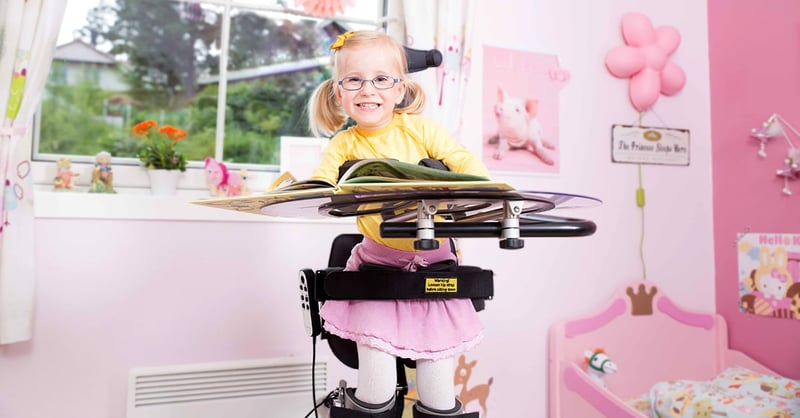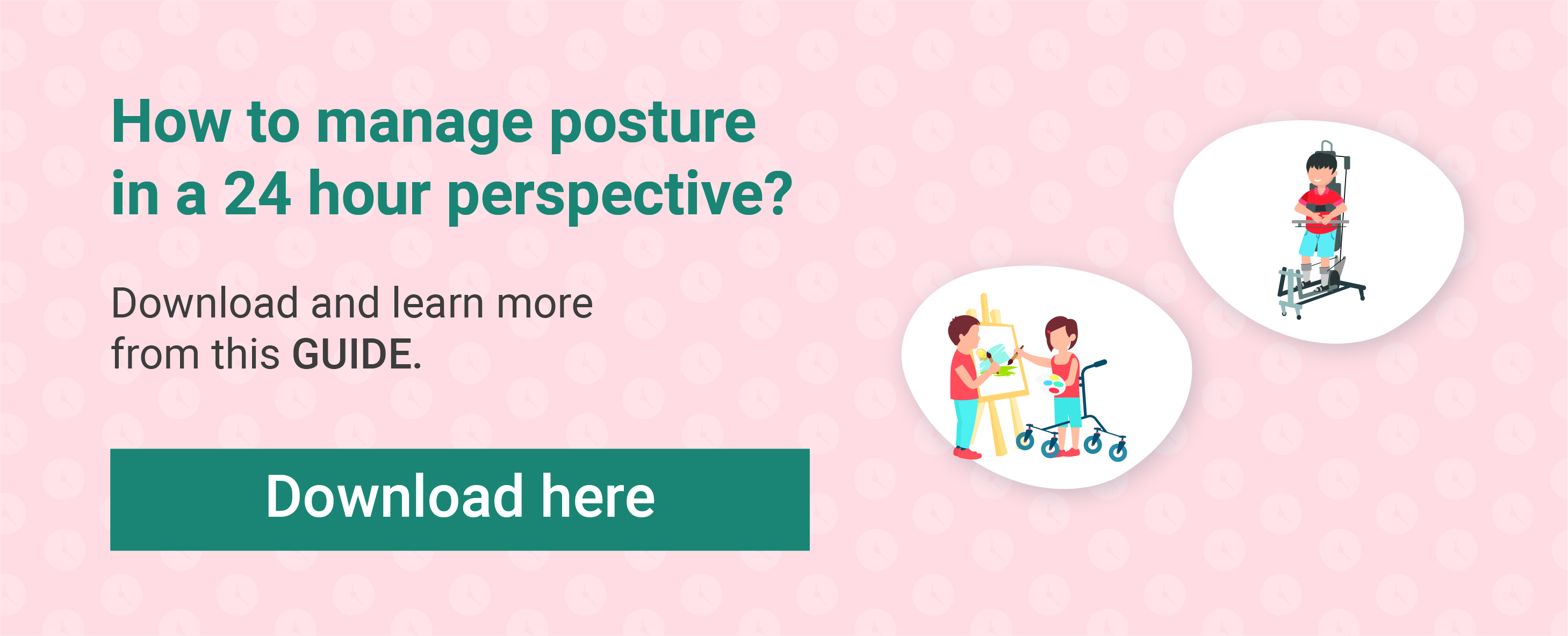12 frequently asked questions about the dynamic stander Innowalk


If the dynamic stander Innowalk is a new assistive device to you, you may have many questions. Here you’ll find answers to the questions we are asked the most about the Innowalk. We hope this will be helpful in your search for the best solution for your child, yourself or the person you care about.
- Who can benefit from using the Innowalk?
- What benefits can I expect from using the device?
- Is there a need of independent mobility or ability to stand to use the Innowalk?
- Are there any contraindications or precautions I need to be aware of?
- How long do you recommend someone uses the Innowalk at a time?
- How much weight-bearing does the Innowalk allow a person to undergo?
- How much active training can someone expect to get in the Innowalk?
- Is it possible to adapt the Innowalk to someone who has contractures and/or scoliosis?
- Is there a need to use another standing device in addition to the Innowalk?
- Which sizes are available?
- What level of service should I expect to maintain the product?
- How do I purchase the device? Is it possible for me to apply for funding or financial support?
1. Who can benefit from using the Innowalk?
The Innowalk is a dynamic stander designed especially for people with limited or no ability to move independently (non-ambulatory). It is suitable for both children, young people and adults. It works by supporting the user in an upright standing position, to allow assisted, guided and repetitive movements in a safe, comfortable way. The Innowalk is suitable for people with moderate to severe disabilities such as:
- Cerebral palsy
- Syndromes such as Rett and Trisomie 21
- Spinal cord injury
- Spina bifida
- Brain injury
- MS
- Stroke
2. What benefits can I expect from using the device?
People with disabilities who may be non-ambulatory are often spending a great amount of their waking hours being sedentary.
The Innowalk allows people with severe disabilities to be physically active. Research has shown that movement in the Innowalk is light physical activity, and it emphasizes the importance of increasing physical activity and reducing sedentary time for people with disability to increase general health outcome, such as respiration, circulation, gastrointestinal function, mobility of muscles and joints, bone mineral density and mental health.
3. Is there a need of independent mobility or ability to stand to use the Innowalk?
No, the dynamic stander is designed to assure safe and comfortable training, regardless of physical function levels, so there’s no need for independent mobility or ability to stand.
4. Are there any contraindications or precautions I should be aware of?
Any bone fractures in the lower limb and/or torso and open skin lesions in areas of the body in contact with parts of the device are contraindications.
Generally, we recommend that individuals who wish to use the Innowalk, in collaboration with a responsible therapist/doctor, assess the potential benefits and any possible risks associated with using the assistive device. However, the presence of the following conditions or symptoms should always be considered before and during use:
- Major deformities (in the column and lower limbs)
- Severe fixed contractures in the lower limbs (hips, knees and ankles)
- Osteoporosis with previous or suspected spontaneous fractures of the lower limbs
- Joint instability in the lower limbs (hips, knees, and ankles)
- Skin lesions affecting areas of the body coming into direct contact with the device
- Circulatory disorders
- Respiratory disorders
- Cardiac disorders
- Epilepsy with uncontrolled seizures
- Severe spasticity that prevents proper positioning and movement in the Innowalk
- Pain in standing with weight-bearing or during movement of the legs
5. How long do you recommend someone uses the Innowalk at a time?
In total, we recommend that the person aim for a minimum of 1 hour/day, based on WHO physical activity recommendations. This total can be divided into 2-3 shorter sessions throughout the day. So, for example, the person might undertake 3 sessions lasting for 20 minutes each. However, the amount of time spent in the Innowalk should always be adapted and continuously evaluated in accordance to the user’s current health condition. It is also recommended to start with short sessions in the beginning and gradually increase the amount of time in the device.
6. How much weight-bearing does the Innowalk allow a person to undergo?
The Innowalk is designed to encourage safe weight-bearing for the user to build up strength and confidence. However, the amount of bodyweight the user will support is depending on the upright position they can achieve. The straighter position, the more weight-bearing is performed by the user.
7. How much active training can someone expect to get in the Innowalk?
The movement in the Innowalk is designed to be performed in a standing position with weight-bearing. The motorised movement stimulates walking-like motions of the legs and arms. Both active and passive body movement are povided. The user can for example, actively override the motor and use their own muscle power. Active movement stimulates muscle activity and is adapted to the user's ability, capacity, and daily condition.
8. Is it possible to adapt the Innowalk to someone who has contractures and/or scoliosis?
Yes, to some extent it’s possible to support misalignment such as contractures or scoliosis. It will always need an individual assessment to decide on the best solution. If the user has contractures in the hips and knees, this can be compensated by the sit to stand function in the Innowalk, allowing the person to have some grades of flexion in the joints. In cases with scoliosis, it helps to use a brace or other dynamic upper-body support for better positioning and to increase comfort for the user.
9. Is there a need to use another standing device in addition to the Innowalk?
A complete standing program should always be discussed with a clinician. General guidelines recommend daily standing for 1-2 hours in total. This means it may be necessary to have different types of devices available to meet all individual and practical needs to reach the recommendations.
10. Which sizes are available?
The device is available in 3 sizes to fit users within the size range from 80 - 200 cm.
Innowalk Small- Height of user 80 – 125 cm
- Max weight of user 35 kg
- Height of user 120 - 165 cm
- Max weight of user 80 kg
- Height of user 150 - 200 cm
- Max weight of user 110 kg
11. What level of service should I expect to maintain the product?
There is a requirement for a technical inspection of the product at years 3 and 5, and then annually. This inspection is carried out by a trained representative. In addition, there will be a need for regular adjustments to the product to ensure optimal settings and positioning in relation to growth and changes in function or needs.
12. How do I purchase the device for myself or to the one I care about? Is it possible for me to apply for funding or financial support?
The system of reimbursement when purchasing assistive devices varies from country to country. We recommend that you start by contacting your local Made for Movement office or distributor for more advice on how to proceed. If we are not represented in your country, you can contact the head office in Norway directly. You find our contact details here.
First published Nov 27th, 2019.

Rikke Damkjær Moen brings many years of experience as clinical physiotherapist to the Made for Movement team. Her mission is to ensure that everybody, regardless of mobility problems, should be able to experience the joy and health benefits of physical activity. As our Medical Manager, Rikke is passionate about sharing knowledge so that individuals with special needs, families, and clinicians can discover the possibilities and solutions provided by Made for Movement.
It's a very special story marked by love, effort, and unstoppable determination. It's about Tom and his family. In the interview,...
A severe accident during a hockey game resulted in 35-year-old Tobias breaking his neck and becoming paralysed from the armpits down....
A disability entails the loss of, damage to, or deviation from bodily or psychological functions, in the form of mental, physical,...
Hear from us from time to time and learn new things
